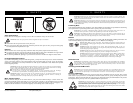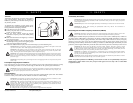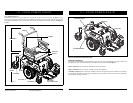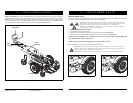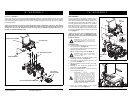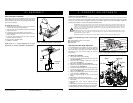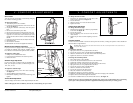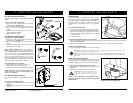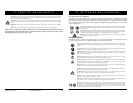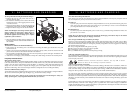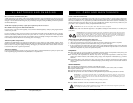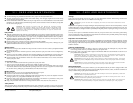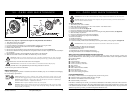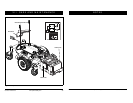
Quantum 610 Series www.pridemobility.com 29
V. COMFORT ADJUSTMENTS
WARNING! The power elevating seat option is intended for use on a level surface only. Never
raise the seat from its lowest position on an inclined surface. Failure to heed this warning can
result in the power chair tipping over.
WARNING! Never raise the seat from its lowest position when operating your power chair on
bumpy or uneven surfaces. Failure to heed this warning can result in the power chair tipping
over.
WARNING! Never raise the power elevating seat while your power chair is in the freewheel
mode.
WARNING! Always fasten the positioning belt when operating the power elevating seat.
NOTE: The power elevating seat option is equipped with a system that reduces the speed of the power chair by
one half when the seat is elevated more than 1-2 inches (2.54-5.08 cm). Always check to be sure this system is
operating properly before using your power chair.
30 www.pridemobility.com Quantum 610 Series
VI. BATTERIES AND CHARGING
BATTERIES AND CHARGING
The Quantum 610 uses two long-lasting, 12-volt, deep-cycle batteries. These batteries are sealed and maintenance
free. Since they are sealed, there is no need to check the electrolyte (fluid) level. Deep-cycle batteries are designed
to handle a longer and deeper discharge. Though they are similar in appearance to automotive batteries, they are
not interchangeable. Automotive batteries are not designed to handle a long, deep discharge, and also are unsafe
for use in power chairs.
MANDATORY! Battery posts, terminals, and related accessories contain lead and
lead compounds. Wear goggles and gloves when handling batteries and wash hands
after handling.
PROHIBITED! Always use two batteries of the exact same type, chemistry, and amp-
hour (Ah) capacity. Refer to the specifications table in this manual and in the manual
supplied with the battery charger for recommended type and capacities.
WARNING! Contact your Quantum Rehab Provider if you have any questions regarding
the batteries in your power chair.
Charging the Batteries
The battery charger is essential in providing long life for your power chair batteries. It is designed to optimize
your power chair’s performance by charging the batteries safely, quickly and easily.
PROHIBITED! Removal of grounding prong can create electrical hazard. If necessary,
properly install an approved 3-pronged adapter to an electrical outlet having 2-pronged plug
access.
PROHIBITED! Never use an extension cord to plug in your battery charger. Plug the charger
directly into a properly wired standard electrical outlet.
PROHIBITED! Do not allow unsupervised children to play near the power chair while the
batteries are charging. Pride recommends that you do not charge the batteries while the
power chair is occupied.
MANDATORY! Read the battery charging instructions in this manual and in the manual
supplied with the battery charger before charging the batteries.
WARNING! Explosive gases may be generated while charging the batteries. Keep the power
chair and battery charger away from sources of ignition such as flames or sparks and
provide adequate ventilation when charging the batteries.
WARNING! You must recharge your power chair’s batteries with the supplied off-board
charger. Do not use an automotive-type battery charger.
WARNING! Inspect the battery charger, wiring, and connectors for damage before each use.
Contact your Quantum Rehab Provider if damage is found.
WARNING! Do not attempt to open the battery charger case. If the battery charger does not
appear to be working correctly, contact your Quantum Rehab Provider.
WARNING! If the off-board battery charger is equipped with cooling slots, then do not
attempt to insert objects through these slots.
WARNING! Be aware that the battery charger case may become hot during charging. Avoid
skin contact and do not place on surfaces that may be affected by heat.
WARNING! If your battery charger has not been tested and approved for outdoor use, then
do not expose it to adverse or extreme weather conditions. If the battery charger is exposed
to adverse or extreme weather conditions, then it must be allowed to adjust to the
difference in environmental conditions before use indoors. Refer to the manual supplied
with the battery charger for more information.



